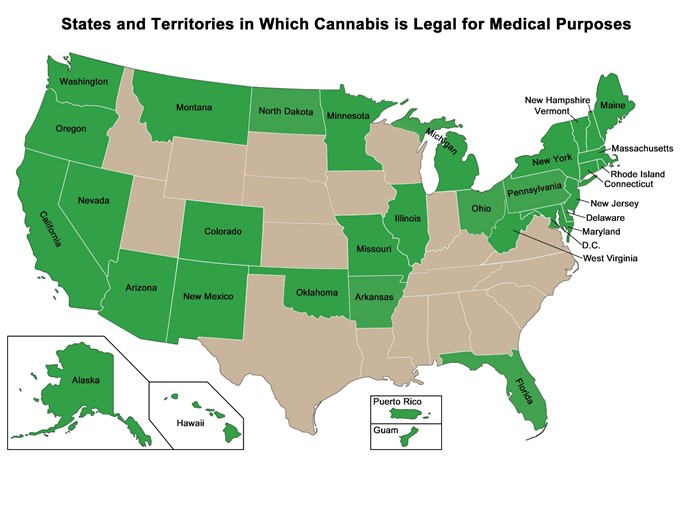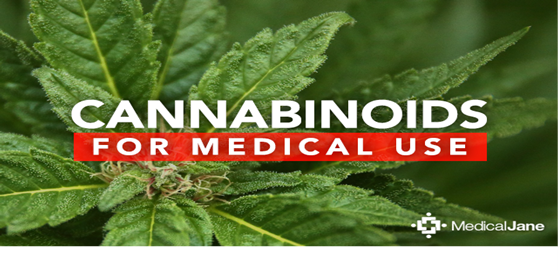Cannabis has been used for medicinal purposes for thousands of years. In the United States, the possession of Cannabis is illegal per federal law, except within approved research settings. However, some states, territories, and the District of Columbia have enacted laws to legalize its medical use. 1
There are over 100 cannabinoids in cannabis including the two main active groups – cannabidiol (CBD) and delta-9-tetraydrocannabinol (THC). CBD activates specific receptors throughout the body to produce pharmacologic effects, particularly in the central nervous system – the brain and spinal – and the immune system. THC on the other hand activates CBD receptors in the brain and leads to “high,” while CBD does not.
The most studied and established roles for cannabinoid therapies include pain, chemotherapy-induced nausea and vomiting, and anorexia. Moreover, given their breadth of activity, cannabinoids could be used to concurrently optimize the management of multiple symptoms, thereby reducing overall polypharmacy. The use of cannabinoid therapies could be effective in improving quality of life and possibly modifying malignancy by virtue of direct effects and in improving compliance or adherence with disease-modulating treatments such as chemotherapy and radiation therapy.


Cannabis products are available in a variety of formulations including tablets, capsules, solutions, oils, edibles, topicals, inhalants, suppositories, etc. Based on the product, it can be purchased by prescription from a healthcare professional, online shops, dispensaries, smoke shops, etc.
It is difficult to determine the quality of the products because they are not regulated like prescription drugs that must be approved by the Food and Drug Administration. Vendors usually provide an analysis of their products and details on production methods to assist in product selection.
Readers’ Questions:
-
What are potential beneficial effects?
-
CBD may have the following beneficial effects:
- Analgesia
- Anticonvulsant
- Antioxidant
- Anxiolytic and antipsychotic effects
- Muscle relaxant
- Neuroprotective
-
THC may have the following beneficial effects:
- Analgesia
- Antiemetic
- Appetite stimulation
- Muscle relaxant
-
-
What is the impact on urine drug screens?
- Most urine drug screens test for THC or its metabolites
- Most hemp oil or CBD products do not contain enough THC to lead to a positive urine drug screen, but very high doses or an impure form of CBD could lead to a positive urine drug screen
- Tests can come back positive for about 7 to t10 days after use, or up to six weeks with heavy use
-
What are the laws and regulations surrounding CBD products?
- In the U.S., hemp-derived products containing no more than 0.3% THC are NOT considered controlled substances and can be sold with certain restrictions, based on state laws and restrictions. Recreational cannabis is legal in Canada
- In the U.S., the FDA maintains the authority to regulate products containing cannabis or cannabis-derived compounds. To date, there is only one FDA-approved CBD product, Epidiolex
-
According to the FDA:
- CBD-based products CANNOT be sold as dietary supplements because a CBD product was FIRST approved as a prescription (Epidiolex)
- Hemp-derived CBD products can be sold in cosmetics (e.g., creams, lotions, lip balms). These do not have to undergo FDA approval
- State laws regarding hemp-derived CBD products vary. Some states may not sell any CBD products. Some may sell hemp-derived CBD products, but only as cosmetics. Some states may sell consumable hemp-derived CBD products (e.g., capsules, tinctures) in addition to cosmetics. Travel with non-FDA approved CBD products may be tricky due to differences in state laws.
Chalice Team
Bibliography
- Cannabis and Cannabinoids:Appetite Stimulation. (n.d.). Retrieved 8 4, 2019, from National Cancer Institute: http://www.cancer.gov/cancertopics/pdq/cam/cannabis/healthprofessional/page4
The National Academies of Sciences, Engineering, and Medicine. The health effects of cannabis and cannabinoids: current state of evidence and recommendations for research (2017). https://www.nap.edu/catalog/24625/the-health-effects-of-cannabis-and-cannabinoids-the-current-state. (Accessed August 4, 2019)- Maida V, Daeninck PJ. A user’s guide to cannabinoid therapies in oncology. Curr Oncol 2016; 23:398-406.

